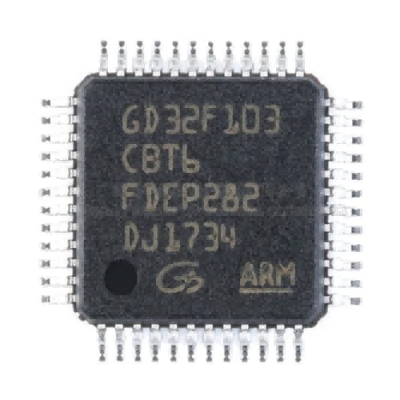GD32F103C8T6
Part Number: GD32F103C8T6
Manufacturer: GigaDevice
Description: ARM Microcontrollers – MCU
Shipped from: Shenzhen/HK Warehouse
Stock Available: Check with us
ICRFQ.com - Electronic Components Distributor in China Since 2003

Part Number: GD32F103C8T6
Manufacturer: GigaDevice
Description: ARM Microcontrollers – MCU
Shipped from: Shenzhen/HK Warehouse
Stock Available: Check with us
The GD32F103C8T6 device is an ARM® CortexTM-M3 RISC-based 32-bit general-purpose microcontroller that offers the best processing speed, low power consumption, and peripheral set. The SysTick timer, Nested Vectored Interrupt Controller, and advanced debug support are all closely coupled with the CortexTM-M3 next-generation processor core.
For maximum efficiency, the GD32F103xx device integrates an ARM® CortexTM-M3 32-bit processor core running at 108 MHz with zero wait states for Flash accesses. Up to 96 KB of SRAM memory and 3 MB of on-chip Flash memory are available. Two APB buses are connected to various improved I/Os and peripherals.
The devices come with up to three 12-bit ADCs, two 12-bit DACs, ten available 16-bit timers, two basic timers, two PWM advanced timers, and a variety of standard and advanced communication interfaces, including up to three SPIs, three USARTs, two I2Cs, two UARTs, two I2Ss, a CAN, a USBD, and an SDIO.
With a temperature range of -40 to +85 °C, the gadget can be powered by a 2.6 to 3.6 V power supply. Several power-saving modes make the ability to optimize wakeup latency and power consumption possible, which is particularly crucial for low-power applications.
The GD32F103xx devices are suitable for various applications thanks to the features above, particularly in fields like industrial control, PC peripherals, power monitor and alarm systems, consumer and handheld equipment, POS, video intercom, vehicle GPS, motor drives, and so forth.
| Attributes | Value |
| Core Size | 32-Bit |
| Program Memory Type | FLASH |
| Core Processor | ARM® Cortex®-M3 |
| Speed | 108MHz |
| Voltage – Supply (Vcc/Vdd) | 2.6V ~ 3.6V |
| Program Memory Size | 64KB |
| RAM Size | 20KB |
| EEPROM Size | 0 |
| Number of I/O | 37 |
| A/D | 10x12bit |
| D/A | 0 |
| PWM | 2 |
| LCD | MOTOROLA 6800 AND INTEL 8080 TYPE LCD DIRECTLY |
| UART/USART | 3 |
| SPI | 2 |
| I2C(SMBUS/PMBUS) | 2 |
| USB Device | 1 |
| USB Host/OTG | 1 |
| CAN | 1 |
| Ethernet | 0 |
| Features | – |
The most recent ARM® processor generation for embedded systems is the CortexTM-M3. It was created to offer a low-cost platform that satisfies MCU implementation requirements, has fewer pins and uses less power, and offers excellent computational performance and a sophisticated system response to interrupts.
Thumb and Thumb-2 instruction sets are supported by the CortexTM-M3 processor, which is based on the ARMv7 architecture. CortexTM-M3 also offers some of the following system peripherals:
The Harvard architecture used in the design of the ARM® CortexTM-M3 processor design allows for the usage of independent buses for loading and storing data and retrieving instructions. The maximum amount of internal storage space for programs and data is 3072 Kbytes of inner Flash and 96 Kbytes of internal SRAM, both of which can be accessed (R/W) at CPU clock speed with no wait states.
Numerous frequencies and clock operations are available through the Clock Control unit. These consist of the following:
Power reset, system reset, and backup domain reset are three types of reset that GD32F10x Reset Control controls. Except for the SW-DP controller and the Backup domain, the system reset resets the processor core and peripheral IP components.
Both the power-on reset (POR) and the power-down reset (PDR) sTo guide the MCU into security, the embedded low voltage detector (LVD) continuously monitors the power supply, compares it to the voltage threshold, and creates an interrupt.
A microcontroller is a component of a semiconductor chip that performs arithmetic processing and regulates the circuit through the I/O and peripheral interface, as you are undoubtedly already aware. The term “32-bit microcontroller” denotes a device that can perform arithmetic operations on 32-bit values. The 32-bit microcontroller executes a function in fewer instruction cycles than an 8-bit microcontroller because of its broader data bus.
Due to its excellent performance, a 32-bit microcontroller is frequently constructed with extra peripherals and memory. For instance, an 8-bit MCU cannot support the NXP LPC1700 series’ four 32-bit timers, SD/MMC, USB, Ethernet Mac, CAN, and other peripherals.
32-bit microcontrollers are power-hungry parts despite their strong performance and abundance of peripherals. Their higher operating frequencies, which range from tens to hundreds of Mhz, are used by them.
You shouldn’t always use a 32-bit microcontroller for a project. It is more expensive than an 8-bit MCU to start. Some designs consider employing a 32-bit microcontroller to be excessive and an unnecessary expense.
Additionally, battery-powered circuits, like wireless IoT sensors, do not work well with 32-bit microcontrollers. They would rapidly deplete the battery while running at the slowest clock rate.
In these situations, 32-bit microcontrollers are a great option:
If you need information or want to order GD32F103C8T6, contact us here at ICRFQ, your leading electronic components in china, and we will ensure you get the best product at the best price.
WhatsApp us